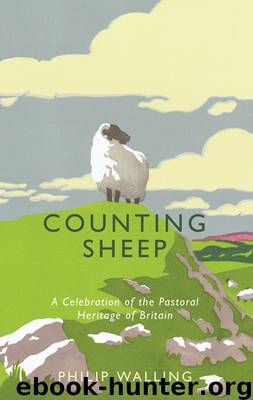Counting Sheep by Philip Walling

Author:Philip Walling
Language: eng
Format: epub
Publisher: Profile Books
9
THE SUFFOLK
It profiteth the lord to have discreet shepherds, watchful and kindly, so that the sheep be not tormented by their wrath, but crop their pasture in peace and joyfulness; for it is a token of the shepherd’s kindness if the sheep be not scattered abroad but browse around him in company. Let him provide himself with a good barkable dog and lie nightly with his sheep.
From a thirteenth-century treatise on estate management, quoted in Eileen Power, The Wool Trade in English Medieval History (1941), lecture II
THE HYBRID EWE IS ONLY THE FIRST CROSS IN THE sheep pyramid. To fulfi l her purpose of breeding high-quality butchers’ lambs she has to be crossed with one of what are broadly called the Down breeds, which all have the same purpose of siring offspring with meaty car-cases. This is the second and ‘terminal’ cross in the pyramid and is where we get most of our lambs destined for the modern meat market. This group of sheep includes many breeds that have never seen a piece of English downland, but they all have in common that they are either directly or indirectly descended from the Southdown, which was the first modern Down breed, created in Sussex largely by John Ellman (1753–1832) over 200 years ago.
In 1780, a decade after Bakewell’s work with the New Leicester, John Ellman of Glynde in Sussex began breeding sheep to satisfy the growing demand from a metropolis becoming hungry for meat. Ellman is credited with turning the native shortwoolled heath breed of the South Downs and the other chalk hills of Kent, Sussex and Hampshire, into a meat-sheep for the London market. And in so doing he created a sheep that not only became the premier breed of the English downlands, but also had a crucial influence in the formation of all the English Down breeds which are the basis of sheep farming across the New World. For, apart from being the ancestor of the Down breeds, the Southdown was, and remains, particularly in the Antipodes, an important breed in its own right. In this it was more successful than the New Leicester, which, once it had done its work, rapidly sank into obscurity. The vital difference between the two was that the Southdown was an improver of its own heath-type relatives, which became the Down breeds, whereas the New Leicester’s value was as a crossing sheep with ewes of entirely different ancestry.
The old type of Southdown that had ranged the uplands in the south of England for centuries when Ellman began his breeding improvements possessed a number of admirable qualities that few other English breeds of the time could match: their short wool was better than any of the other Shortwools, apart from the Ryeland; they were slender-boned with well-flavoured flesh; and importantly their hindquarters, where the most valuable cuts are, were heavier and stood higher than their forequarters; also they not only matured earlier than all the other unimproved British breeds, but they were very frugal users of pasture and the wethers could be ready for the butcher at eighteen months.
Download
This site does not store any files on its server. We only index and link to content provided by other sites. Please contact the content providers to delete copyright contents if any and email us, we'll remove relevant links or contents immediately.
| Anatomy | Animals |
| Bacteriology | Biochemistry |
| Bioelectricity | Bioinformatics |
| Biology | Biophysics |
| Biotechnology | Botany |
| Ecology | Genetics |
| Paleontology | Plants |
| Taxonomic Classification | Zoology |
Sapiens: A Brief History of Humankind by Yuval Noah Harari(13912)
The Tidewater Tales by John Barth(12370)
Mastermind: How to Think Like Sherlock Holmes by Maria Konnikova(6893)
Do No Harm Stories of Life, Death and Brain Surgery by Henry Marsh(6658)
The Thirst by Nesbo Jo(6405)
Why We Sleep: Unlocking the Power of Sleep and Dreams by Matthew Walker(6298)
Life 3.0: Being Human in the Age of Artificial Intelligence by Tegmark Max(5143)
Sapiens by Yuval Noah Harari(5094)
The Longevity Diet by Valter Longo(4835)
The Body: A Guide for Occupants by Bill Bryson(4534)
The Rules Do Not Apply by Ariel Levy(4482)
The Immortal Life of Henrietta Lacks by Rebecca Skloot(4222)
Why We Sleep by Matthew Walker(4167)
Animal Frequency by Melissa Alvarez(4123)
Yoga Anatomy by Kaminoff Leslie(4083)
The Hacking of the American Mind by Robert H. Lustig(4050)
All Creatures Great and Small by James Herriot(3950)
Barron's AP Biology by Goldberg M.S. Deborah T(3925)
Double Down (Diary of a Wimpy Kid Book 11) by Jeff Kinney(3870)
